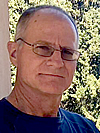
Gary Huckleberry
University of Arizona
2018 Rip Rapp Archaeological Geology Award
Presented to Gary Huckleberry
Citation by Vance T. Holliday
I am pleased to present this citation for Gary Huckleberry’s receipt of the Ripp Rapp Award of the Geoarchaeology Division. He is, of course, a prominent figure in geoarchaeology both nationally and internationally. Gary is one of the key players in investigation and interpretation of alluvial stratigraphic records in the greater Southwest. His chapter on the geoarchaeology of dryland alluvial systems in the highly regarded volume Archaeological Sediments in Context (2001) is a standard reference. Gary’s work on alluvial systems is well integrated into the field in which he is a recognized authority: water management. His research in this arena has been in the Southwest, where irrigation systems are dramatic indicators of a crucial step in subsistence and diet from sedentary foraging to farming. Gary almost certainly knows the geoarchaeology of Southwestern agriculture better than anyone and has published papers and book chapters on the topic for a quarter of a century.
Gary’s abilities and experience are also a component of two international projects: the ancient economy and irrigated agriculture in coastal Peru and Archaic landuse, subsistence, and environmental change recorded in shell middens along the northern coast of the Gulf of California.
Gary also gained attention reconstructing previous field investigations at two site in Washington State. Marmes Rockshelter remained an enigma because a report was never completed long after it was destroyed beneath a reservoir,. Gary was part of a team that worked with the old records to reconstruct the excavations and evaluate the findings. Gary’s work including dating and placing some early human remains in a stratigraphic context. For the controversial Kennewick Man skeletal remains, he applied careful sedimentological work to determine the provenience of the significant as some of the older human remains found in the continental U.S. He clearly demonstrated how careful scientific analyses could inform on these finds far from the prevue of politics.
Beyond his field research, Gary’s other prominent contribution to national and international geoarchaeology is his just-completed tenure as co-Editor of the International Journal of Geoarchaeology. Under Gary’s guidance, along with co-editor Jamie Woodward, the journal significantly expanded in size, readership, and the international flavor of the authors and the research presented in the journal’s pages. Gary is a tireless, relentless, and very fair and conscientious editor. He demands the best of science in a manuscript but also works hard to get the best out of the authors.
In sum, Gary clearly deserves the recognition associated with the Rip Rapp Award based on his many outstanding contributions to the interdisciplinary field of geoarchaeology.
 2018 George (Rip) Rapp Archaeological Geology Award — Response by Gary Huckleberry
2018 George (Rip) Rapp Archaeological Geology Award — Response by Gary Huckleberry
It’s a great honor to receive the 2018 Rip Rapp Award in Archaeological Geology. When I think of the people before me who have been up here at this podium receiving this award, I’m tremendously humbled and grateful.
We stand on the shoulders of giants. I am here today because of the support and guidance of family, teachers, friends, and co-workers. My parents who provided love and emotional support in my childhood to help me succeed in school, and who did not question my eventual choice of doing “dirt” for a living. My wife who helped support me emotionally and financially as I worked towards my Ph.D. My professors in Geography, Anthropology, and Geosciences who shared their knowledge and enthusiasm that inspired me: Stan Swarts and Erik Karlstrom at Northern Arizona University; Rick Reider, Brainerd Mears, and George Frison at the University of Wyoming; and Vance Haynes, Bill Bull, and Vic Baker at the University of Arizona. The Southwestern archaeologists who appreciated the value of geoarchaeology and increasingly incorporated it into their work. My colleagues in the Anthropology Department at Washington State University (WSU) who risked hiring a geologist who would end up lecturing on cultural anthropology and serving on committees with post-modernists. The students at WSU who kept me on my toes and provided me some of the greatest satisfaction that one can attain as an educator.
In our profession, we apply our knowledge towards understanding past cultures. In many ways, we as scientists are a culture (or subculture) with our own system of values and norms that often differ from larger society. In modern parlance, we are nerds… more interested in journal impact factors than football scores. Although I am preaching to the choir, it is safe to say that we did not pursue (or are currently pursuing) a career in geoarchaeology for the money. We obviously value money, but something else drives us, as we could certainly make more money doing just about anything else. A big part of that something else is the fun and excitement of solving mysteries of the past. Another part is receiving recognition from our peers. When our papers get accepted in peer-reviewed journals, it helps us in promotion and leads to new professional opportunities. But there is something deeper. It feels good because we worked hard to produce something that our peers recognize as a worthwhile contribution to the profession. Well, that feeling for me is magnified by winning this award. I don’t consider myself to be particularly brilliant or innovative, but I hope that I have played a role (albeit small) in advancing the discipline. I hope that I have helped persuade others to appreciate geoarchaeology as a field of study that helps us to better understand the past, not just for sake of knowledge itself, but also for providing context to the many challenges that we face today. I thank you for this honor.
